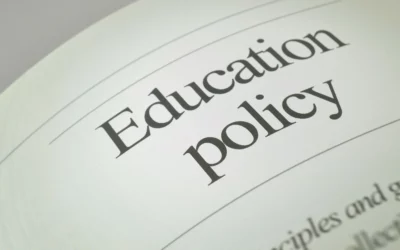
Written by Christine Cooke Fairbanks
January 31, 2024

Sens. Mike Lee and Mitt Romney of Utah are introducing a resolution to designate a National School Choice week in January. It would officialize what is already an annual cultural celebration in January for families choosing an education that works for them.
This congressional resolution comes with the growing surge toward education choice policy across the nation, including in Utah. The movement has even expanded from support of charter schools or advocacy for vouchers to all forms of home-based education, like traditional home schooling and innovative forms of at-home education (the latter includes families who use public funds or resources for their schooling).
Home-based education is growing in Utah and the nation.
A look at Utah
New survey data shows that most (52% to be exact) of Utah parents with school-age children prefer one or more days of home-based education for their students.
The poll captures a post-pandemic reality: Many parents who haven’t considered themselves traditional home-schoolers want some form of home-based education.
Broad desire for home-based education is the result of a cultural shift that has accelerated since the COVID-19 pandemic. Because of school shutdowns, nearly all parents of public-school children experienced schooling at home via remote learning.
In fact, data from spring 2020 to fall 2020 – in the heat of the pandemic – shows that the number of households that reported themselves as home-schooling doubled. Many stayed with it. In fact, home schooling is becoming more popular in Utah. A recent study ranked the state as the third best state to home-school.
Home schooling versus other home-based education
There are important distinctions between different types of home-based education that are important legislatively and legally, but culturally the difference may be fading.
For instance, some families that may want their child at home for instruction may also prefer a traditional public-school curriculum, public funds to help support it, or the structure provided by virtual options like those offered in charter schools and beyond. Some may want all of this but also choose to send their children to someone else’s home for a co-op, pod or microschool. In each unique case, the family may describe their choice as “home schooling” or may say they are doing virtual or private school. Parent-driven, home-based options certainly exist on a spectrum.
Traditional home-schoolers – those who philosophically reject government money – have sometimes opposed education savings accounts and choice scholarships. While many home-schoolers have softened their opposition, they continue to see themselves as separate from those who use public funds.
In fact, new 2024 education choice data breaks groups into separate categories; 2.4% of Utah families are home-schoolers and 0.2% of families in Utah use a private choice scholarship (which could include those using education savings accounts). Breaking out these groups in a data set makes sense, since they use different factors and accountability measures.
Regardless, both groups are part of a growing demographic that prefers to have a hands-on, parent-driven approach to education outside of the traditional classroom setting.
Analysts may safely predict that home-based education will only grow faster in Utah over time, once the Utah Fits All Scholarships are finally awarded this fall and in subsequent years.
A national look at home schooling
Estimating how many kids in the nation are home-schooled is a perennial challenge. While the last federal estimates on home schooling offer data from 2019 – where the estimate for that year was 1.5 million students – others have tried their hand at calculating the number. One estimated that there were up to 3.1 million students home-schooled in the 2021-22 school year.
Toward the end of 2023, The Washington Post published a “hand-compiled dataset” (from 2017-18 school year to 2022-3 school year) to find the most accurate and current numbers of home-schooled children across the nation. A corresponding story estimates there are currently 1.9 million to 2.7 million being home-schooled across the country now. That’s quite a wide range for an estimate, but it is a helpful guide in a murky area.
Aside from those numbers, the piece points out that while some thought the increase in home schooling would die down after the pandemic passed, home schooling has remained a popular option.
In fact, its main takeaway is that home schooling is the fastest growing form of education in the nation. The growth is seen in families choosing to home-school regardless of their politics, geography, demographics, or even how their local public school is performing.
As more states adopt and/or begin their education choice scholarships, the trend toward home schooling or home-based education is likely to expand.
Conclusion
Home schooling/home-based education has largely maintained its momentum since the COVID-19 pandemic, suggesting there’s something attractive about it outside of being a solution in a crisis. If this trend continues, home schooling may once again become a standard feature of American life, as it was prior to the acceptance of the common school and publicly funded systems.
Megan Myres McMillan contributed to the research for this post.

Insights: analysis, research, and informed commentary from Sutherland experts. For elected officials and public policy professionals.

-
Home schooling/home-based education is growing in Utah and the nation, with homeschooling being the fastest-growing form of education in the country.
-
Most Utah families say they want one or more days of home-based education for their students.
-
As more public scholarships for home-school families begin to pay out funds, home-based education should continue to grow.
Read More
Education policy to consider during the 2024 election season
Here’s a look at what each presidential candidate is likely to focus on in education, given their track records and campaign platforms.
Ignoring the text of the Constitution is a mistake
A written Constitution is entirely superfluous if the document is simply meant to give the people what they want.
What you need to know about election integrity
It should be easy to vote and hard to cheat. This oft-quoted phrase has been articulated as a guiding principle by many elected officials wading into voting and election policy debates in recent years. So why has this issue been so contentious, and what’s the solution?


